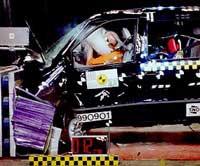New model of traffic accidents

In this new model are surprising consequences derived from the change of speed. At very low speeds, accidents decrease considerably and increasing speed increases the number of accidents. But something similar to a saturation effect occurs, which indicates that despite accelerating a lot from a speed, accidents do not multiply equally.
However, the ability to drive safely depends on many factors, making it very difficult to make safe predictions. However, models help us understand traffic behavior. The model developed by physicists Nagel and Schreckenberg in 1992 is used in several cities to predict every minute the circulatory movement. This model is based on the driver's usual behavior. If there is no drawback, expect the driver to speed up to the speed he likes most, but when approaching other vehicles changes his behavior: it will reduce the crash speed, leaving a margin of safety compared to the previous car.
If drivers always acted this way, there would be no accident. However, the Huang and Wu model is less ideal and includes factors that others have not considered. In them, for example, shocks were only produced when the traffic was heavy, and even when in the real motorways few vehicles circulate.
The Huang and Wuren models also take into account the unexpected behaviour of drivers. As expected, these random behaviors are responsible for accidents, both in speed and traffic density.
The most surprising thing, however, is that when traffic is really heavy, the chances of suffering an accident are reduced because vehicles are forced to move slowly and unified.
Buletina
Bidali zure helbide elektronikoa eta jaso asteroko buletina zure sarrera-ontzian











